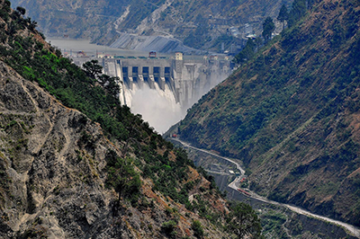
The writer is a businessman and the author of three books including Muslims: The Real History.
Agriculture produces a quarter of Pakistan’s GDP, employs almost half of the country’s labour force, and is a major contributor to its exports. The Indus River provides the water to make this possible; 90 percent of its water is consumed by the agricultural sector. Pakistan experiences rain mainly in the monsoon months of July and August. Since the rains coincide with the snow melt in the mountains that feed the Indus, Pakistan suffers droughts most of the year, and floods after the rains.
Between 1847 and 1947, the British developed the Indus Water Irrigation Basin. Pakistan inherited the system and has developed it further in the 70 years that followed. But now the ageing Indus Basin Irrigation System is beset with serious problems.
– The hostile relations between India and Pakistan create water insecurity.
– The snow melt and the monsoon rains come together, causing destructive floods.
– The arid conditions that prevail in the rest of the year, require more storage for water.
– The flat plains, which descend by a foot per mile into the sea and have no drainage, are consumed by waterlogging and salinity.
– Bad water management aggravates the shortages and wastes.
In 1948, within a year of Partition, disputes erupted between India and Pakistan on the sharing of the waters of the Indus and its tributaries. In 1960, under the supervision of the World Bank, India and Pakistan signed the Indus Waters Treaty (IWT) which gave Pakistan the rights to the Indus, Jhelum and Chenab rivers, and India the rights to the Ravi, Sutlej and Beas rivers in perpetuity.
Between 1960 and 1980, two major dams were built at Mangla and Tarbela, together with major link canals to substitute water from Pakistani rivers for the water lost to India as a consequence of the accord. The system comprising two major dams, barrages, link canals, and a huge network of canals and watercourses was estimated to have a replacement value of $60 billion.
India started the construction of a series of run-of-the-river hydro projects, which has led to serious concern in Pakistan. The first of these was Baglihar, completed in 2009, but many more are on the anvil. Though India is entitled to undertake such projects as long as they return the water back to the river, Pakistan is worried that in times of crises these could be used to close their supply source. On the west, Afghanistan is also considering projects on the Kabul River, which will increase the need for a water accord between the two countries, before the matter develops into a crisis.
Pakistan is short of water for most of the year, but heavy monsoon rains, combined with snow melt from the mountains, often lead to damaging floods. The worst year was 2010, when much of Pakistan’s farmland was flooded, thousands died, 20 million were displaced, and the losses caused by the flood were estimated at $43 billion.
Terrible damage has been caused by flooding, year after year:
– 2003: In Sindh, Karachi and Thatta, 484 people died and 4,476 villages were affected.
– 2007: Khyber Pakhtunkhwa, Sindh, and Balochistan were badly affected by floods that killed 1,000 people.
– 2010: Massive flooding resulted in 2,000 deaths and affected 20 million people.
– 2011: 361 people were killed, over 1 million homes affected, and 1.7 million acres of land were inundated.
– 2012: 100 people died, thousands of homes were destroyed, and thousands of acres were inundated.
– 2020: Floods disrupted life in Karachi, which was totally inundated.
Part of the solution to repeated flooding is to build adequate storage along the Indus. Pakistan lacks storage facilities. Its storage capacity is sufficient for 30 days, as compared to India’s 320-day capacity and Egypt’s 1000-day capacity. Every year Pakistan dumps water to the tune of $21 billion into the sea because it has no facilities to store it. Pakistan needs to build three times as much as the storage reservoirs at the Mangla dam, to avoid this massive waste. The extra storage will ensure water availability during the dry months. At present, Pakistan wastes 50 percent of its water by inefficient use and by letting unused water flow into the sea. It has the lowest crop yield per unit of water and has not developed any modern irrigation methods such as drip irrigation.
Additionally, two of the biggest problems of agriculture in Pakistan are waterlogging and salinity. They affect 43 percent of the area in the Indus Basin irrigation system, which amounts to 7 million hectares. Sindh is the worst affected, with over half of its irrigated and productive land converted into a wasteland. Due to the lack of natural drainage, the rising water table brings the salt up, rendering the land unfit for cultivation. The solution is to build an effective drainage system to remove the saline water and lower the water table. This requires money, which Pakistan has not committed so far. However, the critical nature of the issue necessitates that we act on it without any further delay.
Pakistan’s water management is poor. Thirsty crops, such as sugarcane, which consume a lot of water are farmed without giving any thought to the cost of the water. Pakistan uses more water per unit of the GDP produced than any other country in the world. In making crop choices, our farmers do not take into account the cost of the highly subsidised water. Moreover, no attempt is made to use modern irrigation methods. The entire system is badly in need of maintenance, but funds allocated for repairs are eaten up as a consequence of the collusion between corrupt irrigation officials and crooked contractors.
The work required to refurbish and repair the irrigation system, eliminate waste, better manage water usage, and cut down waterlogging and salinity, requires domestic rather than foreign investment. This would generate employment, and have a fast payback in larger harvests within a year or two. China’s massive water projects demonstrate its capability in this field. Joint ventures can be undertaken with Chinese companies, with Pakistan putting its reclaimed land to use for farming with Chinese capital and management. Public-private partnerships can provide money and management and, additionally, eliminate corruption, which has been a stumbling block in reforming the irrigation system in Pakistan.
The Gilgit-Baltistan area of the Northern Territories is the most suited for building dams, hydropower projects, and water storage facilities. This area has remained unexploited due to India claiming the disputed territory as part of Kashmir. Due to India’s objections and claims, the World Bank, the IMF, and other multilateral banks and donors have refused to finance these projects. Also, the latter are opposed to large dams for environmental reasons. Since 1980, India and the international lending institutions have stood in the way of construction of dams in Pakistan’s Northern Territories. In the period 1980 – 2010, Pakistan has lost over 1000 MAF (million acre feet) of water due to lack of storage.

However, the good news is that with China’s support, Pakistan is currently working on five dams in the North Indus River Cascade, which will cost $50 billion and provide 40,000 Megawatts (MW) of hydel power and provide storage for 15 percent of the annual river flow of the Indus. The cascade will create a series of lakes that will store water and help expand Pakistan’s agriculture base. The investment on these projects will come mainly from China and will be equal to the investment made in CPEC. The Diamer-Bhasha Dam project will address the problem of water storage, flood mitigation and hydro power, and is budgeted to cost $14 billion. Construction will begin in 2020 and end in 2029. It will be Pakistan’s third large dam project. The Diamer-Bhasha Dam will add 1.2 million acres of land for agriculture. All these projects are inspired by China’s megaprojects such as the Three Gorges project and the South-North Water Transfer project.
For 70 years, the development of water storage and hydro projects was stalemated on account of the hostile relations between India and Pakistan. Now, after the Indian action in Kashmir, Pakistan, with China’s aid, has moved forward in tapping its potential in the Gilgit-Baltistan area. Once completed, these projects can unleash a take-off in agricultural production and stimulate the economy by boosting its most important sector: agriculture. However, increased water supply and storage must be combined with education of the farmers community in modern, efficient water-management techniques. (See box)
The most dangerous development in the world has been the use of water as a weapon of war. In the subcontinent, for instance, the growing water dispute between Pakistan and India, one of the world’s most heavily populated regions, poses the greatest nuclear threat to the world.
Initially, the IWT of 1960 was honoured in letter and spirit and survived three wars. However, the situation changed as relations between the two grew more hostile. In 2003, the Jammu and Kashmir legislature called for the revision and abrogation of the Treaty. India looked for some justification to revise or break the treaty, quoting Article 6 of the Vienna Convention which states that the use of terrorism is reasonable ground for withdrawal from the IWT, and the International Court of Justice ruled that a treaty can be dissolved because of a fundamental change in circumstances.
In 2016, after an attack killed 19 Indian soldiers on a military base in Kashmir, Prime Minister Modi threatened to scrap the IWT. Pakistan warned that this could be a declaration of war. In 2019, after the Pulwama attack in which 46 Indian soldiers were killed, India decided to stop the water flow to Pakistan from the eastern rivers; Pakistan responded by saying, “This is actually India’s water. If it is available, we use it; if not, it’s no problem.”
Despite having the largest glaciers in the world, Pakistan is expected to face serious water scarcity in the coming years because of climate change, a burgeoning population, poor maintenance of the water infrastructure, and a total disregard for modern water conservation technology. China is providing the support to construct new dams and develop the water infrastructure, but Pakistan must combine this with widespread education on water conservation and policies that prevent wastage of water. In the opinion of the World Economic Forum, the water crisis poses the biggest threat to Pakistan, moreso than terrorism. Over 90 percent of the water in Pakistan is unfit for human consumption and is a carrier of diseases. India has opted for an aggressive posture because Pakistan’s rivers, the Indus, Jhelum and Chenab, pass through Kashmir before entering Pakistan. The Indus actually starts its journey in Tibet, China and then passes through the Ladakh region of Jammu and Kashmir, before entering Gilgit-Baltistan and then flowing through Punjab and Sindh down to the Arabian Sea. However, the Brahmaputra River of India flows a longer distance through China than it does in India itself, and is called the Yarlung Tsangpo in China. Consequently, China has brought a certain measure of balance into the water conflict between India and Pakistan. Now India has to think twice and factor in China’s response before making any aggressive moves against Pakistan’s rivers and its water supply.
Learning from Israel
Israel has led the way in providing solutions to the global water crisis
Population growth and reduction in poverty levels is adding to the worldwide water crisis and could lead to instability and war, if better water management practices are not introduced. Water shortages are already costing the global economy half-a-trillion dollars a year and soon, more than half-the-world will be facing water shortages. However, the dangerous problem of water scarcity can be solved, and interestingly Israel has been the world leader in providing the solutions. By 2013, Israel’s annual water technology exports were more than $2 billion.
Flood irrigation and sprinkler systems were the traditional form of irrigation. In the early 1930s, Simcha Blass a Polish-Israeli engineer, noticed that one tree of a row of them on a farm was much taller and stronger than the others. He walked over to find out the reason and discovered a tiny leak in a metal water pipe near the tree. So just by accident, Blass discovered that a tiny amount of water in the right place could make a plant grow much bigger and faster than a large amount thrown at it by rain, floods, or sprinklers. The new drip irrigation method developed by Blass revolutionised modern irrigation in Israel and later, elsewhere. Drip irrigation not only cut the traditional water consumption by half in farming, but also doubled the crop yield.
An American-Israeli chemical engineer, Sidney Loeb, discovered that salt and minerals could be separated from fresh water by pushing the sea water through membranes. This method, called reverse osmosis (RO), cost half as much as other methods. By 2014, RO plants produced half of Israel’s drinking water. Incidentally, the price of an RO desalinisation plant is equal to that of a few fighter jets. Desalination has proved to be a major step forward.
Israel is a desert in which the sub-soil water is often brackish. Israeli scientists discovered that there are many types of crops that do not need fresh water, but thrive on brackish water, producing smaller but sweeter fruits and vegetables. Israel led in the world research on genetically modified seeds, specialising in water-efficient crops such as short-stalked wheat and closely bunched tomatoes.
It looked for ways to stop wastage of water. Excessive eating of beef, instead of vegetables, was discouraged since the production of one pound of beef consumes as much water as 17 pounds of vegetables. They invented ways to cut down waste in urban water distribution systems and created one of the world’s most advanced water systems in Jerusalem, where GPS-guided mini-robots crawl through sewers, looking for and fixing leaks without digging and without sending human teams into the sewers. Jerusalem’s water losses amount to 11 percent as compared to Europe’s 20–40 percent, and Cairo’s 60 percent. Israel is now working in India to revolutionise the New Delhi water system through technology. In many countries, sewage waste pollutes rivers and lakes. In Israel, 85 percent of highly purified waste is recycled and reused for agriculture. And today, half the water used for agriculture in Israel comes from highly purified waste. While the world believes that water and air are free, God’s gift to mankind, Israel’s most important discovery was that WATER IS NOT FREE; the state pays for it and recovers the money in taxes. A realistic appraisal of the cost of water greatly reduced waste and resulted in better usage of water. Israel’s desert land saw an agricultural revolution with its drip irrigation, reclaimed water, drought-resistant seeds, recycling of sewage water, and water-conservation policies. Pakistan needs to learn from Israel.



